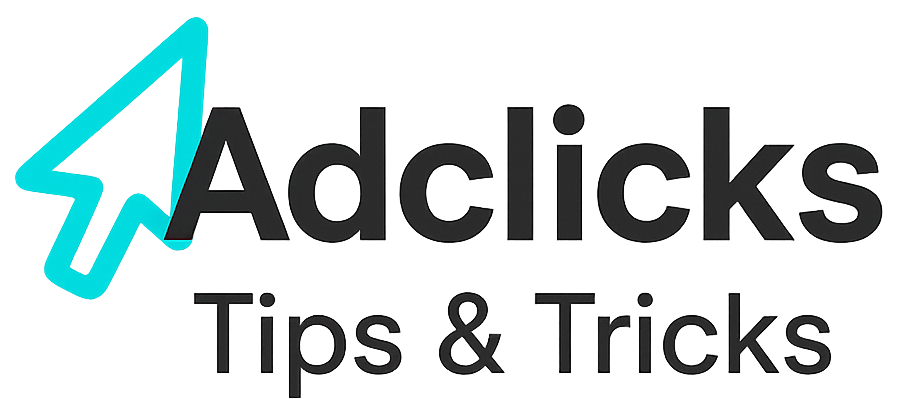Imagine a social platform that blends the viral energy of X (Twitter) with the monetization of OnlyFans and the speculation of a crypto exchange.
That’s the promise of Focus.xyz, a new decentralized social network built on the DeSo blockchain. On Focus, every user operates from a crypto wallet identity, content lives on-chain (not on corporate servers), and creators can actually earn from their posts and social tokens. For publishers and content creators, this unique environment opens up novel ways to build an audience and drive traffic to your own site – all while generating revenue both on-platform and off. It’s a fresh opportunity to engage a tech-savvy community and funnel highly qualified visitors to your content, where you can monetize them via Adclicks or other means.
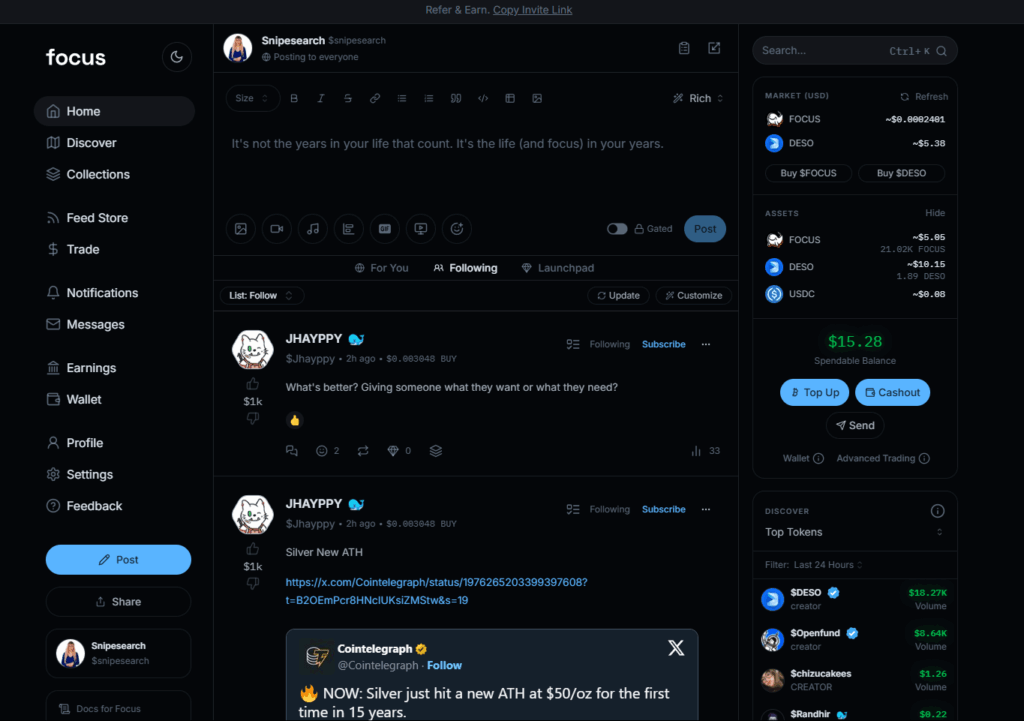
Despite all the buzzwords (crypto, blockchain, tokens), Focus isn’t just for tech insiders – it’s designed to be approachable for everyday creators and readers. The tone of the platform feels familiar: you follow accounts, scroll a feed, and share posts much like you would on mainstream social media.
But under the hood, Focus is radically different: users truly own their profiles and social graph, and there’s no central Big Tech gatekeeper. This means you don’t need to fear an algorithmic chokehold or sudden bans – your content and followers can move with you. For publishers, that decentralization translates to stability and freedom. You’re cultivating an audience in a space that you partially control, not renting it from a corporation. And when those Focus readers click through to your site, they arrive as engaged, intent-driven visitors – the kind that Adclicks and other monetization tools thrive on due to their genuine interest.
Verified Identity and Censorship Resistance
One of Focus.xyz’s core strengths is how it handles user identity. Every account on Focus is tied to a unique crypto wallet, effectively making each user “verified” by cryptography rather than by paying for a blue check. There’s no $11/month fee to prove you are real; your wallet is your verification.

This dramatically cuts down on bots and spam accounts. For publishers, it means the replies and follows you get on Focus tend to be actual people, not fake profiles. A community of real humans is more likely to click through to your articles and engage meaningfully – and real human traffic is exactly what you want when monetizing with networks like Adclicks. (After all, an Adclicks click from a genuine reader is far more valuable than a thousand bot hits.) Focus‘s wallet-based identity system ensures that when you see a follower count or post engagement, it reflects actual individuals, each accountable to their wallet.
Censorship resistance is another pillar of Focus.
All content is stored on-chain and linked to user keys, which means no company – not even Focus’s developers – can secretly shadow ban or remove your posts. If you’ve ever worried about getting deplatformed for an unpopular opinion or having your reach throttled by opaque algorithms, Focus will be a breath of fresh air. The platform is built so that you own your content and identity, similar to owning cryptocurrency in your wallet. This creates a culture of open expression.
Communities on Focus range from crypto traders to artists and outspoken commentators, all sharing without fear of the “dreaded banned account” message. For you as a publisher, it means you can confidently build an audience and drive them to your site without fearing that one day your pipeline will be cut off by a policy change. It’s a bit like having an email list – you retain the connection to your followers.
And importantly, those followers feel a sense of ownership too, which can make them even more supportive. They’re co-owners of their social experience, not just users, and that often translates into loyalty and deeper engagement. In practice, when they land on your website, they’re likely to stay longer and explore – boosting metrics that matter for your advertising and affiliate revenue. (Engaged readers tend to view more pages and click on relevant ads or Adclicks offers, improving your earnings over time.)
Core Features: Posts, Feeds, and Crypto Rewards
On the surface, using Focus.xyz feels much like using any social network. You can create posts (there’s no character limit holding you back), follow others, and build up a feed of content.
Engagement on Focus is further supercharged by crypto-native rewards.
Every post can receive direct tips from other users in a single click, rewarding great content with actual money (in crypto). If you post a compelling snippet or insight from your latest article, readers can literally tip you on the spot as a thanks, before clicking through to read more. Those tips accumulate in your wallet – meaning monetization starts on-platform for even your free teaser content. This dynamic encourages a positive feedback loop: high-quality posts that drive traffic to your site might also earn you some crypto in tips from appreciative readers. It’s a bit like getting both ad revenue when they arrive on your site and a gratuity for sparking their interest in the first place. Underneath a post a user simply puts their mouse over the diamond icon and selects a tip value from 1c to 100k dollars.
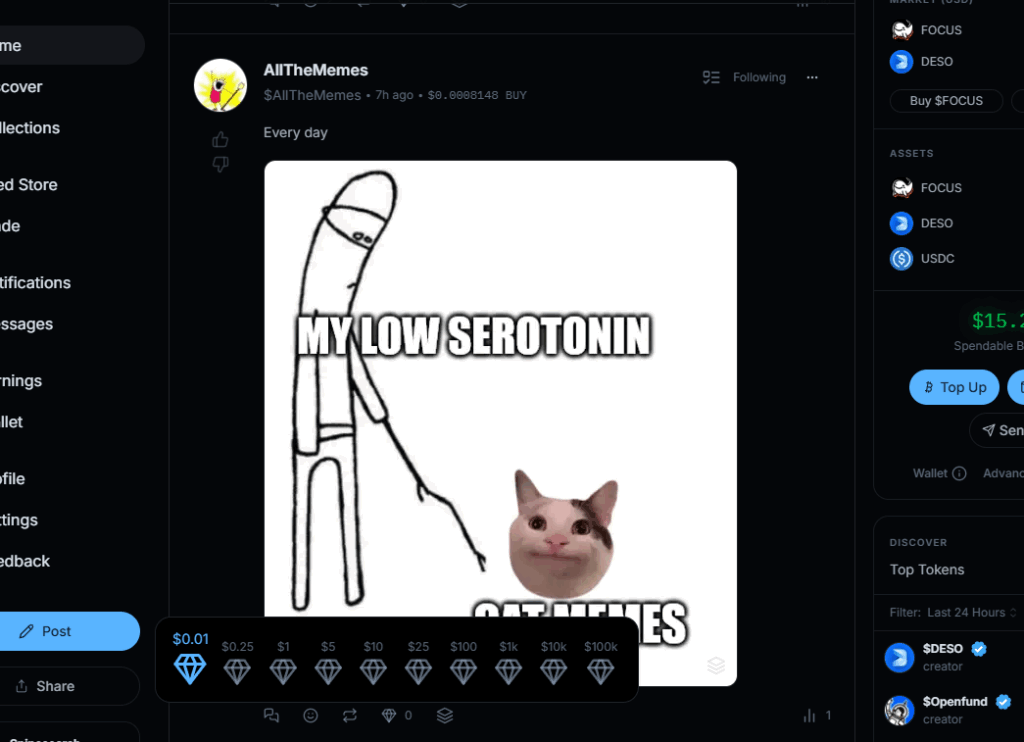
Crucially, Focus has no corporate ads cluttering the feed – you won’t see random sponsored posts for soda or insurance in between user content. Instead, advertising is decentralized through paid reposts, a feature where users themselves act as ad channels. If you want a popular Focus user to share your post or link, you can send them an offer (with an attached payment) to repost it.
It’s like influencer marketing built into the platform. The creator can accept and instantly share your content to their followers with a “promoted” tag, or reject it if it doesn’t fit their audience. Either way, it’s peer-to-peer and transparent. For a publisher looking to amplify reach on Focus , this is a powerful tool: rather than buying a generic ad, you effectively partner with niche influencers whose audience aligns with your content.
Imagine having a crypto analyst with a large Focus following repost your article on the latest blockchain trend – it reaches exactly the right eyes. And because the promotion comes via a user’s own handle, it can feel more like a recommendation than an ad (though it’s clearly labeled). Focus takes a 10% fee from these offers and burns it (more on the burn mechanism later), but the rest goes to the influencer.
In essence, Focus turns advertising into content. For your strategy, it means you might allocate some budget to pay key Focus figures to boost your site’s content, instead of paying a faceless ad network. It’s a refreshingly human approach to ads – one that works alongside traditional web monetization like Adclicks.
You could, for example, promote a post about a new product review you published, get a surge of Focus users clicking through, and then monetize their visit with Adclicks display ads on your page. The difference is those visitors arrive with a sort of endorsement (the repost), which often makes them more receptive – possibly more likely to engage with the content and the ads around it.
Subscriptions, Locked Content, and Creator Monetization
Beyond tips and paid reposts, Focus offers creators a full toolkit to monetize content directly – taking cues from platforms like Patreon and OnlyFans but with a crypto twist. Creators on Focus can set up monthly subscriptions and one-time “locked” content posts for their followers. For instance, as a publisher you might provide a premium analysis or an in-depth guide that only subscribers who pay a monthly crypto fee can access. Or you could lock a particular piece of content (say a downloadable report or an exclusive interview transcript) behind a one-time paywall that users unlock with a crypto payment.

These models are very similar to membership sites or Patreon tiers, except everything is handled in-platform through cryptocurrency. The big advantage? It’s permission less and privacy-friendly – readers don’t have to expose personal info or credit cards to subscribe, and you don’t have to rely on external payment processors. Focus supports payments in various cryptocurrencies (BTC, ETH, SOL, DESO, etc.), and all transactions happen instantly
From the creator’s perspective, Focus’s cut is also much friendlier. Traditional platforms like OnlyFans take around 20–30% of creators’ earnings in fees. Focus flips that around and charges a flat 10% fee on subscriptions and locked content – and that 10% is not pocketed as profit, but used entirely to buy and burn $FOCUS tokens (which benefits the community).
In other words, the platform itself isn’t extracting value from creators; it’s just sustaining the ecosystem token. Practically, this means you keep ~90% of what your subscribers pay, a significantly better margin than legacy platforms. As a publisher, if you have a loyal readership, you could convert some of that audience into paying Focus subscribers for premium content – effectively creating a crypto-based membership program alongside your free content.
And because the transactions are crypto, even micro-subscriptions or pay-per-article models become feasible (no high credit card fees to eat small payments). Readers also remain anonymous if they choose, which can attract those who are privacy-conscious or who simply don’t want adult content or controversial subscriptions showing up on a credit card statement.
Focus’s model inherently respects that anonymity: content is end-to-end encrypted on-chain, so that only you and your subscriber can see the paid posts. Not even Focus’s team can read an encrypted paid post, which is a level of privacy Patreon can’t offer. This can be crucial for sensitive content and builds trust that subscribing on Focus won’t lead to leaks or snooping.
Another novel feature is paid direct messages (DMs). Influential people on traditional social media are inundated with spammy DMs, so Focus introduced a solution: every user sets a minimum price that a stranger must pay to send them a message that lands in their main inbox. It could be as low as a few cents or as high as thousands of dollars for celebrities. If someone really wants to reach you (to pitch a collaboration, for example), they have to put some crypto on the line.
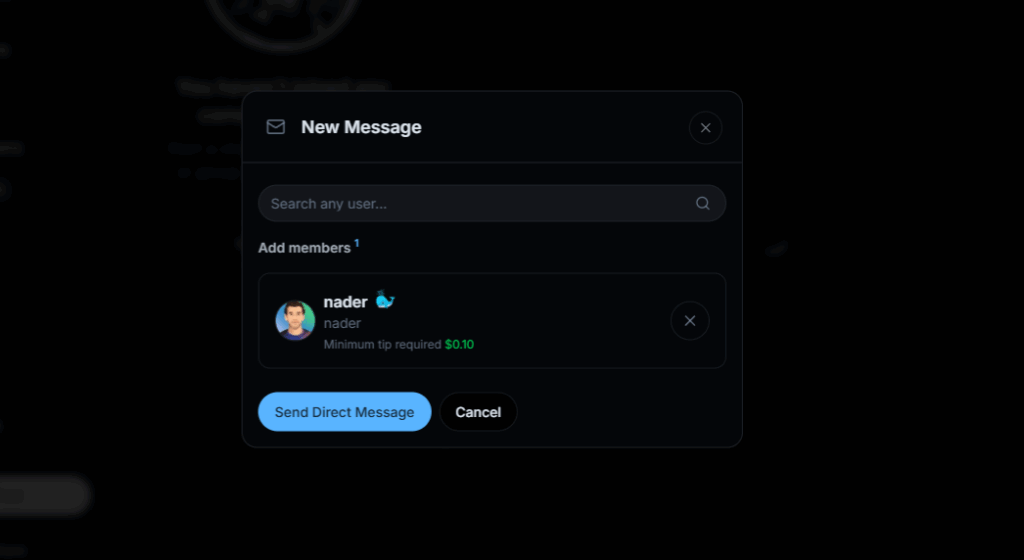
If they do, you get the payment automatically when you read the message. If not, their DM goes to a “spam” folder you can ignore. This mechanism virtually eliminates random spam and creates a new income stream for those with large followings. For you as a publisher, this could be an interesting way to offer consultation or direct Q&A: you might tell your followers that your DMs are open for tips, advice, or feedback – at, say, $5 a message.
Serious inquiries will come through (earning you a few bucks each), while time-wasters likely won’t pay to spam. It’s yet another small revenue channel, and Focus again takes a 10% fee which is burned in $FOCUS tokens. From the traffic perspective, someone who values your content enough to pay to message you is clearly a very qualified lead. That could turn into a business opportunity or simply a highly engaged reader who is more likely to become a customer or a brand advocate. And even if not, it’s monetization for your time and attention that didn’t exist before on free social media.
“Creator Coin 2.0”: Social Tokens on Focus
Perhaps the most ground-breaking aspect of Focus.xyz is its integration of social tokens, sometimes called “creator coins.” If you were around for BitClout (DeSo’s original prototype) or have seen newer platforms like friend.tech, you’ll know the basic idea: individuals can have their own cryptocurrency token that others can buy and trade. Focus takes this concept and supercharges it – so much so that some call it Creator Coin 2.0.
As a publisher or creator on Focus , you have the option to launch your own token (literally at the press of a button) which anyone can trade on the platform’s built-in decentralized exchange. But unlike earlier implementations that used simplistic bonding curve formulas,
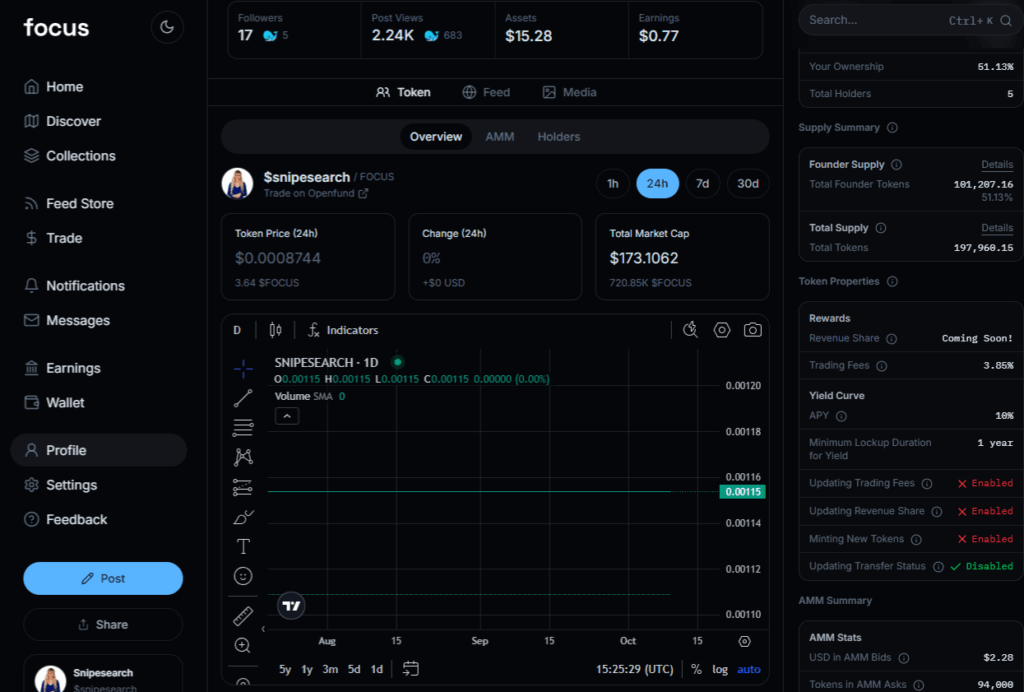
Focus uses a full order-book DEX (decentralized exchange) to manage token trading. What this means in plain English is that your token’s price is determined by real buy and sell orders in a market, much like stocks on a stock exchange – it’s not just an algorithmic curve that goes up as people buy. This system brings major advantages: it allows for things like limit orders and doesn’t automatically crash the price if one person sells a lot. Third parties can also provide liquidity by placing orders, which wasn’t possible with the old bonding curve model. In short, Focus’s token platform is far more robust and less prone to manipulation or sudden “rug pulls” than previous social token schemes.
If launching a token sounds like a crazy idea for a publisher, consider the incentives: Focus lets you earn a percentage of the trading fees whenever your token is traded. You set a fee (say 5%) on trades of your coin; whenever someone buys or sells your coin, that fee is split – half goes to you, a quarter goes to whoever referred you to Focus (if applicable), and a quarter goes to the platform where it’s burned to support $FOCUS token value.
This model is revolutionary because it means you don’t have to “dump” your own coin holdings to make money (a behaviour that plagued earlier social tokens). You could, in theory, never sell a single one of your own coins and still profit handsomely if your coin is popular and being traded actively.
The more volume your community generates, the more you earn – essentially monetizing the volatility and interest in your brand, rather than monetizing scarcity. For example, if you run a niche publishing site about renewable energy, you might launch a token (let’s call it $RENEW). Your readers and supporters on Focus could buy $RENEW to speculate on the growth of your community or just as a show of support.
Now, every time someone trades $RENEW (maybe buying more to hold, or selling some to take profit), you earn a fee. If $RENEW becomes popular, this can add up to substantial revenue without you ever directly charging your community – it’s earned from the market activity around your brand. Focus basically enabled a mini-economy around your content. This is Creator Coin 2.0 in action: more fair, more fluid, and potentially more lucrative for creators than the old “buy my coin so I can cash out” model.
Launching a token on Focus is deliberately made simple. You don’t need to write smart contracts or deal with technical details; Focus uses standardized on-chain profiles for each token. In fact, every token gets its own profile page on Focus, just like a user profile, complete with a unique ticker (no two tokens can have the same handle, solving the problem of copycat coins). You can set a description for your token and even make posts from its profile, sharing updates or engaging with holders. For instance, if you launched $RENEW, you might post announcements about new articles or projects under the token’s profile, and people following the token will see them.
It blurs the line between a social media account and a tradable asset – in a very innovative way. For traders, finding and investing in tokens is straightforward (no contract addresses to fumble with, just search by name). And for you, it’s a new layer of community building: token holders become like shareholders or members of your tribe. They have a stake – however speculative – in your success, which can deepen loyalty.
Now, not every publisher will want to dive into having a crypto token. It does require managing community expectations and comes with the volatility of markets. But even if you never launch your own coin, the presence of this feature on Focus is beneficial.
It attracts a certain audience: crypto enthusiasts, investors, and speculators who are constantly seeking interesting new projects and creators to back. These are users who might not have discovered your content elsewhere. On Focus, that finance-savvy crowd could stumble upon your posts (or your token if you have one) and become long-term followers or customers. In essence, Focus’s token ecosystem serves as both a monetization vehicle and a discovery mechanism. If you do launch a token, you might see people promoting it or discussing it, which further spreads your brand on the platform. And thanks to Focus’s integration with the Openfund DEX, all these tokens (including the main $FOCUS token of the platform) are easily tradeable across the DeSo network’s marketplaces.
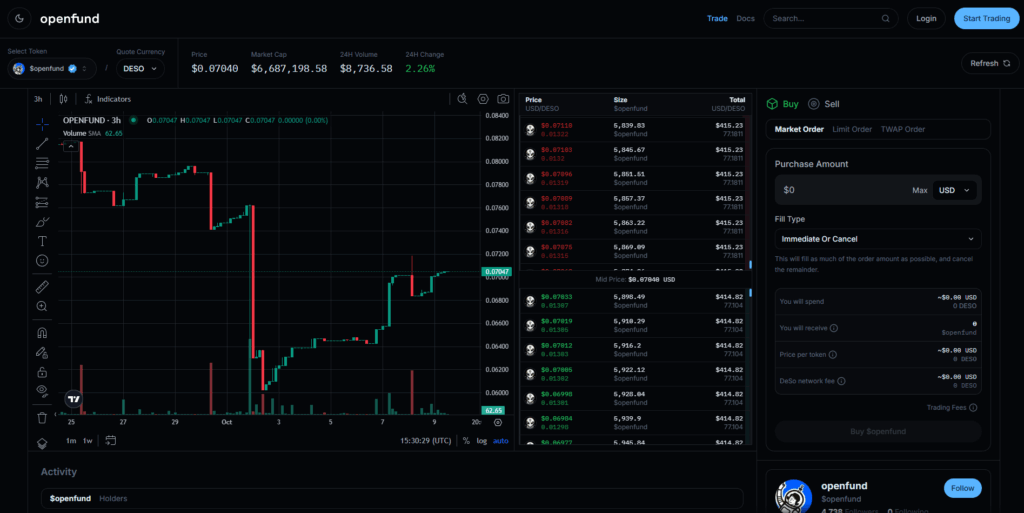
Openfund is a decentralized exchange app that connects directly with Focus; in fact, when you click “Trade” on Focus, it’s Openfund under the hood executing those orders. Seasoned crypto traders might go to Openfund’s site for advanced trading tools, but casual users can trade right within Focus – it’s the same liquidity pool. This means your token isn’t siloed; it benefits from the wider network of traders and even external liquidity from other blockchains that Openfund aggregates. (Focus supports deposits of Bitcoin, Ethereum, Solana, etc., which can be used to buy any creator’s token, giving your coin potentially a much larger investor base than just existing Focus users.)
For publishers leaning into the token idea, a prudent strategy is to use the token to drive engagement rather than treating it as a cash grab. For example, you might airdrop a small amount of your token to your most active readers or as a reward for those who share your Focus posts.
Since tokens can have real value and are tradeable, even a small airdrop feels like a gift (and indeed, Focus itself did a large “social airdrop” to onboard influencers – more on that in the next section). By distributing a bit of your token, you’re literally giving your community a stake in your growth. This can amplify word-of-mouth: if I hold some $RENEW tokens and I know they could be worth more if the community grows, I’m incentivized to spread your content and get others to follow you on Focus.
It’s a viral growth mechanic that aligns the audience’s interests with the creator’s. And again, Focus’s design ensures you’re not losing out by giving away tokens – you actually might gain from the increased trading volume as more people get interested and trade those tokens (remember, you get fee revenue from trades).
In the background, the overall $FOCUS token of the platform benefits too: every trade on any creator’s coin siphons a bit into $FOCUS burn, meaning as usage grows, the platform’s native token becomes scarcer, potentially increasing its value. Early adopters of Focus who hold $FOCUS thus have a vested interest in helping new creators and tokens thrive, completing a virtuous circle. It’s complex under the hood, but the takeaway is straightforward – Focus has built an economy where creators, users, and even the platform token holders all win by driving genuine engagement and growth rather than extraction. For your part, you can participate at whatever level you’re comfortable: purely using social features, dabbling in tokens, or going full SocialFi entrepreneur.
Who’s on Focus.xyz? – Audience and Culture
Focus.xyz launched to a niche but rapidly expanding audience. In its very first week, thanks to a lot of curiosity (and a generous token reservation program), Focus amassed over $75 million in reservations for its $FOCUS token – a staggering number that made waves in the crypto industry.
This early momentum was fuelled by the reputation of the team (the DeSo foundation, led by Nader Al-Naji, who raised over $200M from Coinbase, Sequoia, and others for previous efforts) and by the promise that Focus could be the next big thing in social media. The user base started in the crypto-savvy circles: think of people who had used BitClout, friend.tech, Pump.fun, or who actively trade meme coins and NFTs.
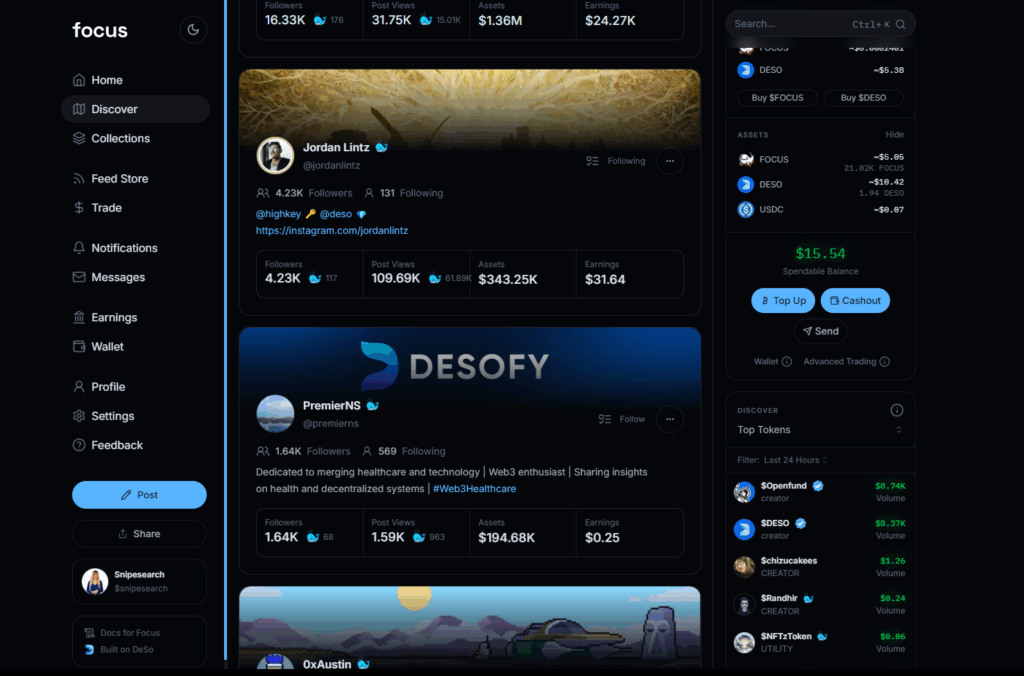
Indeed, Focus positioned itself from the start as the platform for the next generation of social finance (SocialFi) apps. Early adopters included crypto influencers, Web3 builders, and creators who are comfortable with blockchain. Many were drawn by a Social Airdrop campaign – Focus offered bounties (in $FOCUS tokens) for users who joined via referral and proved their influence by linking accounts like Twitter. Essentially, if you had a big following on X, YouTube, Instagram, etc., Focus would reward you with tokens for signing up and posting about it. This led to a surge of signups around early 2025, so much so that the team had to manually process verification and bounty payouts due to the “huge spike in signups” one week after launch. In short, Focus quickly pulled in many well-followed individuals across various creator communities.
So, who are these users culturally? They’re pioneers and entrepreneurial creators. The average Focus user right now is someone who loves the idea of mixing social media with ownership and earnings. They might be a crypto trader posting chart analyses one moment, and a content creator sharing a behind-the-scenes vlog the next.
There’s a strong vibe of experimentation – people on Focus are trying new monetization tricks, sharing tips on how to grow, and openly discussing the platform itself (features, token price, etc.). In the early days (and still now to an extent), crypto content dominates: you’ll see a lot of conversations about token launches, market trends, and NFT art.
The integration of a trading exchange means trending topics on Focus can often be specific tokens or hashtags related to crypto projects. This is great news if you run a finance or tech publication – the audience is hungry for news and analysis, and they’ll actively seek it out.
Sharing your relevant articles on Focus can tap into that demand directly. One could argue Focus is like Twitter with an economic layer, and that tends to foster what we might call a “money-aware” culture. Users are witty and meme-savvy (as in any social network), but there’s also an undercurrent of “How can we profit from this or turn this into an opportunity?” That might sound mercenary, but it actually creates high engagement for content that has real value.
If you drop a genuinely insightful post (say, breaking down a new DeFi trend or offering a tutorial), the Focus crowd is likely to amplify it because they see the utility – it could make them money or make them smarter, and they might even tip you for it. In contrast, low-effort spam tends to get ignored or called out since everyone’s identity is tied to their wallet and reputation.
It’s not all crypto though. Focus also appeals to independent creators fed up with traditional platforms. Think of writers, artists, adult content creators, and community leaders who got tired of algorithms burying their work or moderators taking down their content elsewhere.
Focus’s promise of no censorship (aside from illegal content, presumably) and direct monetization draws in those who feel constrained on Patreon, OnlyFans, or even YouTube. For instance, an educator who found Patreon’s fees too high might experiment with offering crypto subscriptions on Focus.
Or a cosplayer who’s active on OnlyFans might try Focus to sell exclusive photo sets for crypto without the same stigma or payment hassles. These niches are still emerging on Focus, but they are present and growing. The platform’s marketing explicitly name-dropped OnlyFans and Patreon as targets to disrupt, which hasn’t gone unnoticed by those creator communities.

As a publisher, it means the Focus audience isn’t just one monoculture – it’s a mix of various subcultures who share one thing: they’re early adopters and they’re engaged. They have a bit of skin in the game (some hold $FOCUS or creator tokens, many have earned or spent money on the platform), so they care about what happens on Focus. This contrasts with a casual Twitter or Facebook user who might passively scroll without investment. A Focus user is more likely to click on a link that piques their interest, because they’re in an active discovery mindset and the overall environment encourages following through (sometimes literally, as referrals and rewards encourage exploring content).
In terms of geography, Focus‘s userbase is global but with strong representation in tech hubs. The United States has been a major source of early users (not surprising given the Silicon Valley backing and English-language launch) – anecdotal evidence and posts on the platform often reference US events or use English. However, other pockets have shown up: crypto enthusiasts in Europe and Asia, for example, have joined as word spreads. Decentralized platforms often catch fire in places where people are both tech-literate and looking for alternatives to incumbents.
It wouldn’t be surprising if places like Turkey or India (which have vibrant crypto communities) are contributing significant users – one early traffic peek suggested a chunk of Focus interest from outside the US, for instance, Turkey had notable engagement in a related DeSo context. Focus’s audience might be modest in size now, but it punches above its weight in terms of engagement and virality.
What interests do Focus users signal? Given the platform’s nature, topics like finance, tech, blockchain, gaming, and entrepreneurship are hot. You’ll see trending tags about NFT projects, AI innovations, startup ideas, trading tips, and sometimes internet culture memes.
There is also a current of free-speech and anti-establishment sentiment among some users – a reaction to the censorship on mainstream platforms. That doesn’t mean Focus is a wild west of toxicity – remember, identities are tied to wallets, and one person can’t easily run 100 sockpuppet accounts without considerable effort or cost.

The community, at least so far, values constructive contributions (with a dash of healthy scepticism and humour that any internet community has). For a publisher, this means if you engage with Focus users sincerely – for example, by asking their opinions in a post, responding to comments, or even rewarding good feedback with a small tip – you can build goodwill quickly.
The culture rewards transparency (since everything is on-chain) and collaboration. Some creators have even crowdsourced ideas or funded content through their token on Focus. Imagine posting, “Which topic should I investigate next? Vote by tipping this post, and I’ll allocate budget accordingly.” These kinds of interactions are happening, and they further blur the line between content consumer and content supporter.
In practical terms, a Focus user who comes to your website is likely to be a more qualified lead than, say, a random Facebook visitor. They arrived via a context that matches your content (Focus’s open algorithm and social sharing mean that if they saw your link, it was probably in a relevant discussion or feed).
They often come with a mindset of engagement rather than mindless browsing. This is gold for on-site metrics: such visitors tend to have lower bounce rates and higher conversion rates. If your landing page aligns well with the post that brought them (more on that soon), you stand to gain not just a one-time pageview, but potentially a new loyal reader or customer.
And as far as monetization goes, engaged visitors are the ones who click on ads or sign up for newsletters. With Adclicks on your site delivering ads tailored to your content, Focus visitors often see those ads as a continuation of their interest (e.g., a Focus user who clicked an article about electric cars might see ads for EV accessories on your page – highly relevant and not intrusive to them). Because Focus is feeding you highly targeted traffic, your Adclicks revenue can benefit from the contextual alignment between Focus discussion and your content and ads. In summary, Focus’s audience might be smaller now, but it’s enthusiastic, growing, and aligned with digital trends – making it a potent source of meaningful, qualified traffic for publishers who know how to speak their language.
Strategies to Drive Traffic from Focus to Your Website
Building a presence on Focus.xyz and channeling its users to your own website requires a blend of traditional social media savvy and understanding of Focus’s unique mechanics. Here’s how you can make the most of it:
1. Establish Your Profile and Credibility: First, join Focus. When setting up, connect your existing social accounts like X/Twitter if you can, it signals to Focus users that you’re a real person or brand with history. Fill out your Focus profile with a clear bio and your website link.
Because every user is essentially “verified” by their wallet, there’s less worry about impersonation, but you still want to stand out as the official you. If you have a trademark name, the Focus team might have reserved it (they set aside certain common or brand names), so try claiming it or a close variant.
The more recognizable your profile, the more likely people will click on it and follow through to your site. Also consider getting your account verified in the eyes of the community by being active and providing value. There isn’t a blue check mark to apply for – it is earned through consistent, quality posts and engagement. Early on, engage with popular users in your niche: reply to their posts with insightful comments, maybe drop a supportive tip here and there.
This puts you on the radar of their followers. Unlike on Twitter where a new account’s replies can get buried, Focus surfaces content more democratically (especially if you have even a small amount of $FOCUS or social capital, your interactions carry weight). By being genuinely helpful or interesting in discussions, you’ll attract profile views. And guess what’s on your profile? Your website link. Ensuring your profile link points to a compelling landing page (like a “About us with free resources” page rather than a generic home) can capture those who come via profile curiosity.
2. Post Engaging Content with Smart Linking: Just like any social platform, if you want to drive traffic, you need to post content that makes people want to click. On Focus, the audience appreciates substance. A strategy that works well is to share bite-sized insights or teasers from your longer content. For example, if you have a blog post titled “10 Ways Renewable Energy is Changing Cities,” don’t just drop the title and link.
Instead, post a short thread or a series of posts where you highlight a few surprising facts or a statistic from the article, and then say
“👉 Read the full analysis here:”
followed by the link. Make sure to use relevant hashtags or even tag relevant Focus users if appropriate (the platform supports hashtags – these can help your post be discovered via search or by users following that tag). Because Focus has no character limit, you have flexibility: you could write a mini-summary or an intriguing question to spark discussion, with the link at the end. The key is to match the intent.
If the Focus community is currently buzzing about a topic, tailor your posts to join that conversation. For instance, if a certain NFT collection is trending and you have an article about NFT investing tips, start by referencing the trend:
“Everyone’s talking about CoolCats NFT prices today. It reminds me of principle #3 in my NFT investing tips – don’t chase hype without fundamentals. I wrote about this exact scenario last week. Check it out here: [link].”
This approach is both timely and relevant, increasing the odds that Focus readers will click through. It’s not interruptive advertising; it’s contributing knowledge to an ongoing discussion, with a link for those who want more depth.

3. Use Paid Reposts (Influencer Marketing) for a Boost: If you have a budget for promotion. Identify a few creators on Focus who have a large following in your niche.
Focus conveniently lets you see how many followers a user has, and you can observe the engagement on their posts. Approach them through the paid offer system by sending a piece of your content as an offer to repost. For example, if you run a finance newsletter, find a Focus user known for finance commentary with, say, 5k followers.
You can offer them a certain amount of DESO (or any crypto) to repost your link post about “Top 5 Market Trends this Week.” If they accept, your content will appear in their feed with a promoted tag – reaching all their audience directly. Because it’s coming from someone their followers trust, the click-through can be very high, much like a native endorsement.
This is precision ad targeting – akin to hiring a niche influencer to share your article. Since Focus is still relatively new, the cost for these reposts can be quite reasonable (some users might accept small offers if your content is good and non-spammy, because it also gives them content to share). It’s advisable to start with a modest offer and see the results. Track how much traffic you get from it (you could use UTM tags or just monitor your analytics around the time of the repost).
If you find a particular user’s audience responds well (e.g., lots of clicks, maybe even Focus users signing up on your site or leaving comments), you can build a longer-term relationship – maybe even negotiate a regular deal off-platform. Paid reposts are essentially Adclicks in social form – instead of banners on a website, you’re placing content in a social feed. Both aim to drive clicks.
In fact, you might find that the conversion from a Focus repost is higher than a typical banner ad, because of the contextual fit and implicit recommendation. One could imagine blending the two: a Focus influencer repost drives users to your site, where they find an Adclicks banner or native ad that further engages them or directs them to a product. Each step is relevant: the influencer’s audience is interested in your content by design, and on your site the ads are matched to that content contextually, making the entire journey cohesive.

4. Optimize Landing Pages for Focus Visitors: Once you start getting Focus traffic, make sure the pages they land on meet their expectations and capitalize on their interest. If you shared a specific article, it’s straightforward – they land on that article page. Ensure that page is well-structured: a clear headline, an easy-to-read layout, and maybe a summary at top in case they came for a quick takeaway. Consider adding a blurb or banner on those pages welcoming Focus readers (you can detect the referrer in your analytics – if it’s Focus, display a small note like “Hello Focus.xyz friends!”).
It’s a subtle touch that can delight users who realize you’re aware of the platform (it signals you’re part of their community). More importantly, ensure that the content delivers on what was promised in your post. This is classic landing page intent matching: if your Focus post said “5 Tips,” don’t send them to a generic homepage or a sign-up form; send them to the article with those 5 tips.
If they feel misled or have to hunt around, they’ll bounce – and you risk losing credibility. Keep the path to value short. Focus users often have multiple things competing for their attention (they might have just come from an exciting token trade or a lively discussion thread), so hook them quickly with your content. Use subheadings, images, or even embedded media to keep them engaged.
Now, monetization on the landing page is a delicate balance. The Focus user is open to ads if they are relevant – they’re used to “promoted” content that is well-targeted from the platform. Make sure any Adclicks affiliate offers on that page are related to the content. The beauty is, if you’re using something Snipesearch Adclicks contextual ads, it auto-matches context. For instance, on that renewable energy article, Adclicks would automatically show ads about solar panels or EVs rather than random unrelated banners, thanks to its contextual matching engine.
This relevancy means the Focus reader is more likely to be interested in the ad, perhaps clicking it for more info (which earns you CPC revenue). Arrange your ads so they don’t interrupt the flow too early – maybe one mid-article and one at the end or sidebar – to avoid turning off a user who’s not accustomed to heavy ad clutter (recall, Focus’s feed isn’t full of ads, so a page plastered in banners could feel jarring). However, they do understand monetization; many Focus users expect a free website to have ads or offers.
As long as they perceive them as enhancing or at least respecting the content experience, they’ll accept them. Less intrusive formats (e.g., in-content native ads or nicely integrated banners) can actually feel like part of the journey – like “oh, here’s a relevant product/service related to what I’m reading”. If you nail this, Focus visitors might click on those ads at a high rate, turning into Adclicks earnings for you.
In effect, Focus can send you fewer but higher-quality visitors, and your job is to convert that quality into value: engaging them with great content, then offering a logical next step (whether that’s an ad, a newsletter signup, or recommended reading). Many publishers report that traffic from niche social platforms often have longer time-on-site and more pages per visit than generic traffic.
If a Focus user clicks one of those, it’s a double win – they’re now browsing your site deeply, which not only increases the chance of ad impressions/clicks but also inches them closer to perhaps becoming a regular visitor. Treat Focus users like VIP referrals: give them a great experience and they can become evangelists for your content back on Focus, tagging you or sharing your links to others.

5. Consistency and Timing: Consistency is key in social media, and Focus is no different. Stick to a posting schedule so your followers know you’re active. Maybe you share a new article every morning or start a discussion thread in the evening. Focus doesn’t (yet) have the noise level of Twitter, so you don’t need to post dozens of times a day – a few solid posts per day or even one per day can be sufficient to keep you visible. Because content lives longer on Focus (fewer users, less feed churn), each post can have a longer tail of discovery.
Use that to your advantage by posting in times when your target audience is online. This might require some experimentation: are the crypto folks more active on Focus during US market hours or late nights? You can gauge by engagement patterns. There’s also the global element – if you have a multilingual audience, you could post at various times to catch different regions. Unlike highly localized platforms, Focus’s user base is spread out, so any time could yield eyeballs somewhere. Some creators double-post content 8-12 hours apart to hit different time zones, adjusting the wording slightly to keep it fresh.
You might try this with your top content pieces. Just ensure not to overdo pure self-promotion. Mix in some non-link posts too – such as quick thoughts, questions, or even reposts of others’ content you find valuable (maybe comment on a trend or share an interesting stat without a link). This keeps your profile from looking like a pure link dump. You want to be seen as a community member, not just a marketer. The funny thing is, when you are a genuine participant, people are more likely to trust your links and click them.
They recognize you’re there to contribute, not just siphon clicks. Over time, you can build a following on Focus that mirrors your readership. Some might prefer to always consume via Focus; others will regularly click to your site. Either way, you’ve extended your brand presence onto a new platform, adding another channel for audience growth.

6. Monitor Analytics and Adapt: Use your website analytics to monitor traffic coming from Focus (it should show up as referrer focus.xyz). Look at metrics like pages per session, time on site, and conversion goals (if you have any, like sign-ups or ad clickthrough’s, track those from Focus visitors). Compare them to other social traffic sources. You’ll likely notice Focus traffic behaves differently – often more engaged.
If something isn’t performing (e.g., a particular type of post gets lots of impressions on Focus but few clicks), analyse why. Maybe the teaser wasn’t compelling enough, or the link was buried too low in the text. On the flip side, if you see that Focus users who land on a certain page have a very high bounce rate, that page might not be what they expected or it loads poorly. Use this feedback loop to tweak your content strategy. Perhaps you’ll find that listicles do great on Focus but long essays need a stronger intro on the Focus post to get traction. Or maybe Focus readers love interactive content – you might embed a poll in your article and mention on Focus “take our poll (in the article) to see community results.” Learning these preferences allows you to fine-tune what you share.
Remember also to thank or acknowledge when Focus drives significant traffic or engagement. You could publish a Focus post like, “Wow, 500+ of you visited our site today from Focus – glad you enjoyed the article on AI art tools. What would you like to see next?” This not only humanizes your brand, it actively involves the audience in your content creation, strengthening their connection.
And people love being part of a success story; if they feel they helped you by visiting or giving feedback, they’re more likely to do it again. It’s not unlike how a community forum would operate, just distributed. As you adapt, keep leveraging the strengths of Focus: authenticity, niche targeting, and monetization integration. Unlike some platforms where external links are penalized, Focus doesn’t algorithmically downrank them (there’s no evidence of that, and given the ethos, it’s unlikely to secretly nerf external links). So you’re playing on an even field – it simply comes down to interest and relevance. If you provide those, the traffic will flow naturally.
By consistently applying these strategies, you’ll find that Focus can become a steady source of traffic that grows over time. And since the platform is young, your efforts now have compounding returns: a year from now, Focus might have ten times the users, and you’ll be glad you established a foothold early.
Some of those early followers could become major influencers themselves, and they’ll remember you as one of the valuable voices on the platform – perhaps even returning the favour by linking to your site or token unprompted. In community-driven networks, goodwill can lead to organic promotion. Every link click or share you earn on Focus is more meaningful because it’s interest-based, not algorithmically forced. It’s the kind of traffic that converts into loyal readership and revenue if you nurture it. And importantly, Focus traffic is your traffic – you earned it by participation, not by bidding on keywords or paying for social ads (aside from the optional repost deals). This makes the ROI very high.
The cost is mainly your time and creativity, and the return can be thousands of engaged visitors who generate ad revenue, affiliate sales, or even direct crypto contributions to your project. It’s a new frontier, but one that rewards the classic publishing virtues: know your audience, provide value, engage authentically, and monetize intelligently (with tools like Adclicks ensuring you maximize the value of each visit). Focus.xyz essentially hands you the tools to do all of that in one integrated experience.
Connecting the Dots: Openfund, NFTz, and the DeSo Ecosystem
Focus doesn’t exist in a vacuum – it’s part of the broader DeSo (Decentralized Social) ecosystem. Two other platforms particularly worth understanding are Openfund and NFTz, which interlink with Focus to enrich the user experience (and by extension, offer more opportunities for publishers).

Openfund is the decentralized exchange (DEX) and launchpad for tokens on the DeSo blockchain. When you hear about trading $FOCUS or a creator’s coin, Openfund is the engine making that happen.
In fact, Focus directly uses Openfund for all its token trades – if you click the “Trade” section in Focus, you’re essentially interacting with Openfund ’s order-book through a simplified interface. For power users, Openfund’s own site (or app) provides advanced charts, trading tools, and algorithmic trading options for any DeSo token.
Why does this matter for a publisher? Because Openfund can amplify the financial aspect of your presence on Focus. Let’s say you launched that $RENEW token for your renewable energy content. On Focus, your followers can trade it casually. But outside of Focus, on Openfund, even people who aren’t into social media might discover your token if it’s performing well. Openfund has its own user base of traders looking for promising projects. It even allows algorithmic strategies and bots.
So, if your token gains traction, it could attract liquidity from pure crypto traders. More liquidity and trading interest mean a more stable token price and potentially more fee earnings for you. It’s like having your stock listed on an exchange that anyone (even off the social platform) can access. Moreover, Openfund supports deposits from multiple chains, so an Ethereum whale could deposit USDC and buy your $RENEW without ever touching the Focus app. For publishers thinking long-term, this opens doors: you could raise capital or fund projects by issuing a token that serious investors can get into via Openfund, all while your community on Focus engages with it socially.
Openfund also has a feature for algorithmic market-making (AMM) with order-books, which Focus uses to help creators launch tokens with built-in liquidity. In simple terms, when you create a token, you can configure an initial selling schedule (prices at which you’re willing to sell tokens to early buyers) and the funds from those initial sales automatically set up buy orders below to support the price.
This ensures a more orderly market – you’re not left on your own to figure out liquidity. From a user perspective, it means when someone goes to trade your token, they often see a healthy order book rather than extreme volatility. It builds confidence that this isn’t a fly-by-night scheme. As a publisher, you likely want to focus on content, not micro-managing token liquidity, and Focus/Openfund’s design handles a lot of that heavy lifting for you, guided by the experience learned from BitClout and others.
The integration of Openfund is so seamless that many Focus users might not even realize where Focus ends and Openfund begins – they just know that trading works smoothly. But it’s good for you to know, because if you ever want to, say, host a token sale or reward event, you might go to Openfund’s interface for more control or analytics.
Also, Openfund’s existence means transparency: you can point savvy community members to the Openfund sidebar or DeSo block explorer to verify your token’s supply, trades, and holders at any time. Trust is crucial when asking people to invest in your social token, and being open about the data (which is all on-chain) helps build that trust.
Now, let’s talk NFTz – the NFT marketplace in the DeSo world. NFTz is described as a social NFT marketplace, supporting all sorts of digital collectibles from 3D art to audio, with auctions and galleries. How does this connect to Focus ? In a few ways.

First, Focus itself currently doesn’t have a full-featured NFT marketplace interface (its Focus has been more on posts and tokens). However, the DeSo blockchain supports NFTs as a native feature, and Focus users can mint, post, and discuss NFTs, even if the actual buying/selling might happen via NFTz or another DeSo node.
For example, you could mint an NFT on DeSo (using a tool like NFTz or a command-line if you’re technical) and then share it on Focus – your followers can see it, like or comment on it, and if they click to purchase or bid, it might take them to NFTz or initiate a transaction via NFTz’s backend. From the user’s standpoint, it’s a cohesive experience: they see an item on Focus and can acquire it seamlessly. As a publisher, this means you have an avenue to sell digital assets or collectibles to your Focus audience. Suppose you have infographics, exclusive photos, or even short video clips from an event. You can mint these as limited-edition NFTs on DeSo and announce on Focus
“New NFT drop: [Title]. Only 10 available!” Interested users can jump in, and because their DeSo wallet is already connected (Focus requires a wallet login), buying the NFT is just a couple of clicks. NFTz is effectively the marketplace facilitating the exchange, ensuring the transaction is secure and that the NFT ownership updates on-chain. They also provide a showcase for your NFTs outside of Focus; someone browsing NFTz might stumble upon “Creator: YourName – NFTs created”, giving you additional exposure.
One neat aspect is status signaling via NFTs. On some social platforms, people show support or affiliation by sporting badges or profile picture NFTs. Focus doesn’t have built-in profile badges yet, but given that the same DeSo identity spans platforms, an NFT minted as a badge could be recognized across the ecosystem. NFTz and another app called Diamond have done experiments where owning a certain NFT gives your profile a check mark or special design. So, for example, you could reward your top Focus followers by minting a custom “Gold Member” NFT and distributing it (either selling or airdropping).
Those NFTs, viewable on NFTz, prove that someone is a key supporter. In the future, Focus might integrate such visuals – and even if not, you can manually acknowledge NFT holders by giving them perks (say, only people with your NFT get to access a private Focus post – a kind of token gating Focus can enforce via Associations). We saw earlier that Focus creators can “token-gate their community” as an alternative to Discord.
If an NFT was used as, say, a genesis badge for early supporters, the owners of it might get recognized or enjoy some status on Focus or related apps.
For instance, a Focus user could say “I own SN!PED Genesis NFT #005” and others in the DeSo community know that’s from a notable collection (the NFT itself can be viewed on NFTz or other sites). This cross-pollination of content – your social posts, your tokens, your NFTs – all being connected through the DeSo blockchain means as a publisher you can build a multi-faceted digital brand. You’re not just a blog or just a social account; you could be an economy, with your own coin and digital merchandise (NFTs), all of which your audience can own a piece of.
A Focus user who sees you discussing an NFT drop might click over to NFTz to bid on it. It’s an interconnected web of platforms, and that’s by design – Decentralized Social aims to have a constellation of apps sharing the same social data. For a publisher, it means your investment in one platform (Focus) isn’t siloed. You gain discoverability on others like NFTz or Diamond, and possibly future ones like a video app or a forum app, all using the same network.
It’s like having your Twitter, YouTube, and Patreon all interoperable – fans from one can instantly become fans on the other without rebuilding your presence from scratch. This synergy can amplify your reach: maybe a reader finds your article through a Google search, sees an embedded Focus post on it (Focus posts are all public so you could even embed them on your site), then follows you on Focus; then they notice you have a cool NFT series on NFTz and buy one; now they have your token and NFT, so they join a Focus group chat you host for holders; and so on. Each piece reinforces the others. Meanwhile, you continue to monetize along each dimension: on your site with Adclicks and traditional methods, on Focus with tips/subscriptions, via your token with trading fees, and via NFTs with sale proceeds and possibly resale royalties. It’s a diversified yet cohesive strategy.
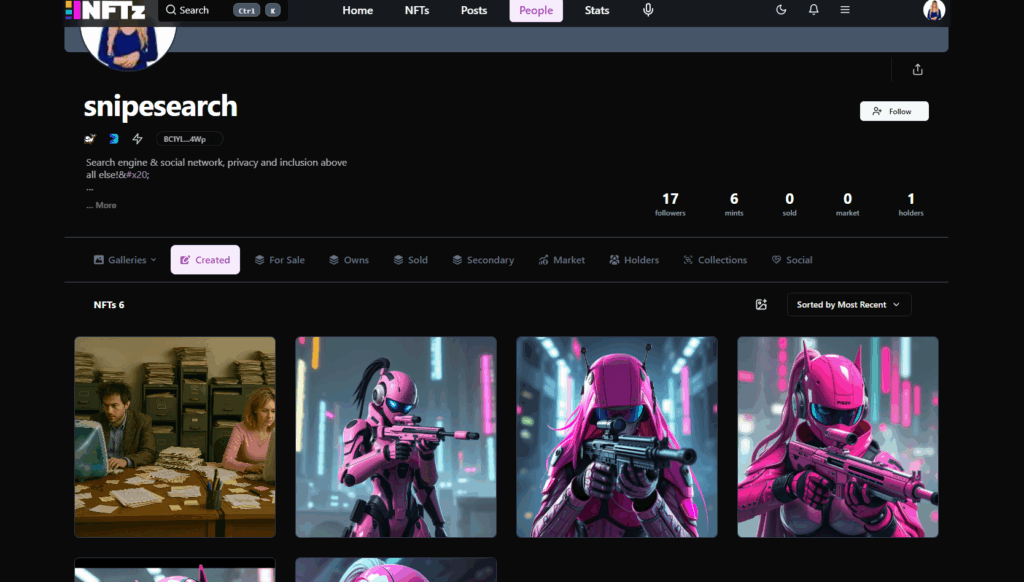
Let’s not forget that NFTz and Openfund themselves have their own tokens and communities (for instance, there’s an $NFTZ token as a utility token for NFTz, and Openfund has governance tokenomics too). If you become an active publisher on Focus, you might also engage with those communities. For example, participating in Openfund’s governance discussions could put you in touch with the hardcore DeSo developers or traders – networking that might yield collaborations or insights (maybe you get a scoop on a new Focus feature by chatting with a dev on Openfund’s channels).
It underscores that Focus is part of a larger social-financial movement. As a publisher, plugging into this movement can have intangible benefits: early access to trends, a say in platform direction, and a reputation as an innovator in the decentralized social space. Those can translate into traffic and monetization indirectly as well – being known as “one of the first media brands on Focus” can draw curiosity and goodwill from the community.
Openfund and NFTz are two pillars supporting the Focus experience. Openfund brings the financial depth and trust (large-scale trading, fair token mechanics, transparent supply info) that make Focus’s social tokens viable and attractive to serious users. NFTz brings the creative and ownership dimension, enabling trade of unique content and status symbols that enrich the social experience. Both influence user behaviour on Focus.
For instance, the knowledge that they can freely trade on Openfund might encourage more users to buy your creator coin (they know it’s not a dead-end investment, they can exit or increase easily). That means more engagement for you. NFTz’s presence signals to artists and collectors on Focus that their art and collectibles have a home – which could encourage more visual artists to join Focus and share work (some Focus posts, in fact, are people showcasing NFTs or designs, since they know they can sell them on NFTz). This could attract a whole new segment of audience to Focus beyond just text-based content. And if your publication has any visual element (say you run a photography blog), you might find an enthusiastic audience among those NFT art aficionados.
Every piece – Focus posts, Openfund trading, NFTz items, website content – is working in concert. It’s an entire ecosystem of engagement and monetization that simply isn’t possible on Web2 platforms where everything is siloed and you can’t port value across. This is the power of Focus and its sister platforms: the whole is greater than the sum of parts. And as you tap into it, you’re not just gaining traffic, you’re building a community that has financial and emotional investment in your success.
Monetizing Focus-Driven Traffic: From Adclicks to Long-Term Loyalty
Driving traffic from Focus to your site is only half the game – the other half is monetizing that traffic effectively and sustainably. We’ve touched on some monetization points in passing, but let’s focus (no pun intended) on how to turn those highly qualified Focus visitors into revenue, while also setting yourself up for long-term growth.
Ad Revenue and Contextual Ads: One of the most straightforward ways to monetize any web traffic is through advertising. Given the niche, interest-driven nature of Focus referrals, contextual ad networks like Snipesearch Adclicks are particularly well-suited here. Adclicks automatically serves ads that match your page’s content and your visitors’ likely interests, meaning Focus visitors see ads that resonate with what they came to read. As discussed, this can lead to higher click-through rates and earnings per visitor compared to generic traffic, because the ads feel more like relevant recommendations than random banners.
For example, if a Focus user arrives on your site reading about decentralized finance, Adclicks might display an ad for a crypto exchange or hardware wallet – something that user is quite likely to consider clicking. Importantly, Adclicks supports multiple revenue models (CPC for clicks, CPM for impressions, CPA for actions, etc.), so you earn whether the user just views the page (and thus serves an impression) or actively clicks an ad.
Focus users often spend good time reading and possibly exploring related pages, so you could accumulate several ad impressions per Focus visitor. With Adclicks’ automatic contextual matching and responsive ad slots, you don’t have to micromanage which ads show – you just place the ad code and let it optimize. It’s wise to experiment with ad placement: maybe a medium rectangle within the content for desktop, and a sticky banner at the bottom for mobile.
Because Focus users are engaged, they won’t be instantly turned off by seeing an ad, provided it’s not overly intrusive. In fact, Adclicks emphasizes less intrusive, more relevant ads that “blend into content flow”. This approach aligns with the user-first mentality of decentralized social; you’re not blasting pop-ups or autoplay videos at them, you’re offering something that might genuinely interest them.
Over time, as you gather data, you might find that certain topics from Focus monetize extremely well (e.g., posts about investing yield high CPC ads) while others are more for building audience (e.g., creative writing posts might not have high-paying ads but attract loyal readers). Use those insights to balance your content strategy. The revenue from Focus traffic may not be solely in on-site ads either – if Focus visitors sign up for your newsletter or follow you elsewhere, that’s future monetizable events beyond the first visit.
Adclicks and Beyond – An Integrated Approach: You can have Adclicks ads running alongside affiliate links and still aim for direct conversions – it’s about placement and priority. Perhaps on the first screenful of your page, you focus on engaging content and maybe an inline ad or two. In the middle, you have a section “Want more? Sign up / Buy X” for the direct conversion push. At the end, you might have a few affiliate product recommendations or a resource list. A deeply engaged Focus reader might scroll and interact with multiple elements – maybe they ignore the banner ad but click your course signup, or they skip the signup and click an affiliate link to a book you recommended.
Each action is a win. The key is to keep it contextual and not overwhelming. Focus users appreciate efficiency – they won’t want to wade through pop-ups to read your piece. But well-placed opportunities that genuinely add value can do very well. Adclicks comes in handy here since it’s designed to be set-and-forget yet relevant, reducing the need for you to manually curate ads. While Adclicks brings in the steady baseline revenue (every visit yields some impressions or clicks), the other methods can bring spikes (each sale or signup is a bigger one-time payoff). Together, they diversify your income.
Building Long-Term Loyalty: Not all Focus traffic value is immediate or monetary. Some of it is strategic – getting the right people onto your platform. Think of Focus as a place to identify and attract influential or highly engaged users. For example, you might notice a particular Focus user with a sizable following regularly engages with your content.
That person could be worth nurturing: maybe invite them to write a guest piece on your blog (which they’ll likely share on Focus, bringing in more of their followers), or simply build rapport through comments and DMs. If they become a champion of your brand, they could drive a lot of traffic your way over time without you having to do anything – essentially a brand ambassador. Focus makes it easy to connect with these folks (as opposed to the black box of traditional social media where you can’t easily see who your top contributors are or reach out without friction).
Use those paid DMs or just regular DMs (if they follow you back) to thank people, offer them something exclusive, or collaborate. Maybe you launch a Focus “Publisher’s Coin” coalition with a few other content creators – a sort of cross-promotion group where you all hold each other’s tokens and occasionally shout out each other’s work. These collaborations can amplify reach and are facilitated by the platform’s social finance angle (everyone has an incentive to see others succeed if they’ve invested in them).
In terms of retention, try to capture Focus users into your own user base whenever possible. That could mean getting them to join your email newsletter, follow your traditional social accounts, or join a forum or Discord you run. Since Focus itself is relatively new and its future growth, while promising, isn’t guaranteed, you want to make sure you’re not putting all eggs in one basket. Get those valuable users on multiple channels.
A simple method: have a prominent email signup on pages likely visited by Focus users, with copy that might appeal to them (“Join 5,000+ tech enthusiasts – get our crypto-social media trend report weekly”). Since they found you through a cutting-edge platform, acknowledge that spirit in how you talk to them. Once they’re on your email list or other channels, you can engage them even outside Focus, multiplying their value. And ironically, that might send them back to Focus to discuss your latest email or article, generating a virtuous cycle of traffic. For instance, you send a newsletter mentioning some data or claim, a Focus subscriber starts a thread about it on Focus to discuss, linking your content, and now new people on Focus see it and click through… it’s easy to see how things can grow organically this way.
Monetizing Focus Itself: We shouldn’t ignore that you can also monetize on Focus in parallel. While our focus (again with the pun) is on driving traffic outward, your Focus presence can directly generate revenue that complements your site’s revenue. If you gain many followers, those tips from appreciative readers can accumulate. If you offer a premium Focus subscription (maybe posting some locked content exclusively for subscribers), that’s monthly income.

And if you have your social token, any trading fees from it are another income stream. These on-chain earnings can be significant over time. They can effectively fund content creation that then feeds back into attracting more readers. For example, tips you earned on Focus might pay for commissioning a freelance contributor on your site, whose article then draws more Focus traffic – which leads to more tips and so on. It’s a different model from the classic “advertiser pays publisher to show content to user.” It’s more triangular: “user directly pays publisher for good content; publisher uses content to attract more users; some content is also monetized by advertisers but in a relevant way.” Adclicks fits in here by being relatively unobtrusive, so it doesn’t scare away those direct supporters.
In fact, Adclicks’s contextual approach can be framed as additional content – some Focus users might view a well-placed ad as another link worth clicking, not an annoying ad, since it aligns with what they care about. That’s the holy grail of advertising – when an ad is genuinely useful to the reader (like an ad for a new analytics tool in an article about social media growth hacks). You might even get feedback from a Focus user like, “Hey, I found X product through your site’s ad and it’s great!” which reinforces that your site is a valuable resource hub.
Analytics and Adjustment for Monetization: Just as you track traffic, track monetization metrics for Focus traffic specifically. If you can segment in your analytics, look at RPM (revenue per thousand visits) for Focus visitors vs. others. Early on, you might see a high RPM due to their engagement. If it’s indeed higher, that’s a sign to invest more effort into Focus. If not, identify the bottleneck: Are Focus users bouncing before seeing ads? Then perhaps integrate the content and ads more smoothly or test different placements.
Are they consuming content but not clicking affiliate links? Maybe the offers aren’t appealing enough or not prominently shown. Iteration is key. The beauty of a platform like Focus is you can even ask the community for input: “I noticed many of you visited our site. What did you think of the experience? I’m open to suggestions.” You might get candid feedback like “The page was too slow on mobile” or “Would love if you had a dark mode.” Implementing such feedback not only improves monetization indirectly (through better user experience) but also endears you to the community (people love being listened to).
Finally, keep the big picture in mind: Focus.xyz is still evolving. New features (perhaps advertising models, discovery algorithms, or analytics) could roll out. Stay informed by following the Focus founders (like @nader) and official updates.
It’s a dynamic environment, and that dynamism is exactly what makes it ripe for those willing to dive in and experiment. In monetization, as in traffic, Focus rewards those who are proactive and community-centric. If you bring genuine value to the Focus community, not only will you earn from it (in tips, coin revenue, etc.), but you’ll also siphon off a steady stream of high-quality traffic to your own properties where Adclicks and other monetization channels turn that engagement into dollars. This dual play – on-platform and off-platform monetization – is the hallmark of a modern content strategy in the Web3 era.
In essence, Focus can be an engine that drives not just page views, but revenue and growth on multiple fronts. By weaving together the opportunities it provides – social virality, direct monetization, token economies – with your existing monetization stack – contextual ads, affiliate marketing, subscriptions – you create a robust model where each audience interaction has the potential to generate value. And because Focus usage itself compounds (followers beget more followers, etc.), your monetization potential can compound as well. It’s an exciting time to be a publisher, when a single social platform can simultaneously act as a content host, a crowdfunding platform, a trading floor, and a referral source. Harnessing all those aspects is the challenge, but also the thrill.
As you refine your approach, keep the community’s trust at the heart of it. In a decentralized network, reputation is everything – it’s what encourages someone to click your link or buy your token. Monetization then becomes a natural outcome of providing consistent value and being an active, positive participant in the Focus ecosystem.
Action Plan: Getting Started with Focus.xyz and Driving Results
To wrap up, here’s a straightforward action plan you can follow to leverage Focus.xyz for traffic and revenue. These steps will help you navigate from initial setup to advanced monetization, ensuring you cover all the bases:
- Join and Set Up Your Focus Profile: Go to Focus.xyz and create an account. Secure your username and set up your DeSo wallet (using email or seed phrase). Fill out your profile with a clear bio, website link, and profile picture. Tip: Connect your X/Twitter or other socials during onboarding to claim any signup bounties and show your credibility.
- Learn the Landscape and Engage: Spend a few days browsing Focus. Follow relevant creators in your niche, read trending posts, and observe what content gets traction. Start engaging by liking, commenting, and even tipping a few posts you find valuable. This warms up your account and puts you on the radar. Remember: Every interaction is tied to your wallet identity, so meaningful engagement builds your reputation.
- Share Valuable Content Consistently: Begin posting your own content. Aim to post at least once per day to stay visible. Share a mix of content: some teaser posts with links to your site (e.g. highlight a key point then “Read more 👉 [link]”), and some non-link posts (questions, insights, or even quick polls if appropriate). Use hashtags for discoverability and tag others if referencing them. Ensure your linked content matches the post’s context to encourage clicks and trust.
- Utilize Focus Monetization Features: As you gain followers, set up monetization on Focus itself. For example, enable tips on your posts (they’re on by default – acknowledge big tippers with a thank you), and consider creating a subscription tier if you have premium content to offer on Focus (like exclusive tips or Q&A sessions). Even a $5/month subscription from a handful of loyal Focus fans is bonus income. Also, experiment with paid reposts: identify an influencer in your category and send a small offer to repost one of your best link posts. Gauge the traffic impact and scale if it’s effective.
- Drive Traffic to Optimized Landing Pages: When Focus users click to your site, make it count. Optimize your landing pages for Focus visitors: ensure fast load times, mobile-friendly design, and content that delivers on what your Focus post promised. Place clear calls-to-action on these pages, whether it’s “Subscribe to our newsletter” or links to related articles. Also integrate Adclicks ads in spots that get seen (mid-article, sidebar, or after the first few paragraphs) – these will automatically show relevant ads to capitalize on the visitor’s interest.
- Capture and Retain the Audience: Don’t let Focus visitors be one-and-done. Encourage them to stay or return. Use pop-ups or inline forms to invite them to join your email list or follow your other social channels. For example, “Join 10,000 readers for free weekly insights” – Focus users who sign up can become long-term assets. You can also invite them to follow you on Focus itself with a gentle nudge on your site (“Follow us on Focus for daily tips”). This creates a loop where they see your content both on Focus and off.
- Leverage Openfund and NFTz (Advanced): If you’re ready to deepen engagement, consider launching a creator coin on Focus /Openfund. Navigate to the token section on Focus and follow the steps to create your token (choose a ticker, set an initial fee%). Announce it to your followers and explain its purpose (e.g., “$RENEW token launched! Holders get special perks and you support our work”). Even if you start small, it officially makes your community a stakeholder. Simultaneously, if you have digital assets (art, guides, collectibles), try minting an NFT on NFTz. Then post on Focus about it – you can even set an auction and count down with your followers. These moves can galvanize your core fans and also open new revenue streams (trading fees from your coin, sales from NFTs).
- Analyze, Iterate, and Expand: Use your site’s analytics and Focus’s feedback to analyze what’s working. Check referral traffic numbers, bounce rates, and Adclicks earnings for Focus visitors. If certain topics or post styles get more clicks and conversions, double down on those. On Focus, note which posts get the most engagement or bring new followers. Adjust your content timing and frequency based on when your target audience is active. Engage in Focus’s built-in analytics (if available) or simply observe patterns (like increased notifications at certain hours). Over time, refine your approach – maybe you’ll do a weekly AMA (Ask Me Anything) on Focus to boost engagement, or a monthly “top supporter” shoutout to encourage more tips.
- Build Community and Collaborations: As you grow on Focus, treat your followers like a community, not just traffic sources. Host occasional giveaways or contests exclusively for Focus users (for example, “Retweet (Repost) this on Focus and win a free 30-minute consult”). Encourage user-generated content – maybe ask followers to share their ideas or use a hashtag you create. Also, collaborate with other Focus creators: you can cross-promote each other, appear in each other’s content, or even co-launch a small project. This not only increases reach but also credibility via association. When the community feels invested in you, they’ll actively drive traffic to your work without prompting (word-of-mouth on Focus is powerful, as users can earn by referring others).
- Stay Updated and Adapt: Finally, keep an eye on Focus platform updates, and be ready to adapt strategies. Join the official Focus or DeSo forums/discord if they exist, follow Focus’s account for announcements, and listen to user feedback. If new features roll out (like improved discovery algorithms, or perhaps Focus introducing its own Ad revenue share program or something akin to that), be among the first to experiment. Early movers often gain an edge. Likewise, stay compliant and respectful – Focus values its positive, user-driven culture, so avoid spammy behavior that could get you flagged by users or moderators. By staying in the community’s good graces, you ensure a long-term presence.
By following this action plan, you’ll gradually establish a strong foothold on Focus.xyz and translate it into tangible traffic and revenue results for your publishing business. Each step builds on the previous, from getting started to becoming an integral part of the Focus ecosystem. Remember, consistency and authenticity are your allies. Focus is a marathon, not a sprint – but it’s one where even early strides can yield significant rewards in audience growth and monetization. Good luck, and happy focusing on your success!
Relevant Links
- Support: https://support.snipesearch.co.uk/
- FAQ: https://adclick.snipesearch.co.uk/index.php?page=index/faq
- Contact Form: https://adclick.snipesearch.co.uk/index.php?page=user/support
Stay Connected
- Snipesocial: https://www.snipesocial.co.uk/pages/snipesearch
- Twitter: https://twitter.com/snipesearch_uk
- Facebook: https://facebook.com/snipesearch
- LinkedIn: https://linkedin.com/company/snipesearch/
- VK: https://vk.com/snipesearch_uk
- Focus: https://focus.xyz/snipesearch
- YouTube: https://youtube.com/@snipesearch
- diaspora: https://diaspora.snipesearch.net/people/7431fcf0806c013e936e00163c6e7bdf
Analytic Tools
StatCounter: https://statcounter.com/
Rommie Visitor Analytics: https://rommie.net/
